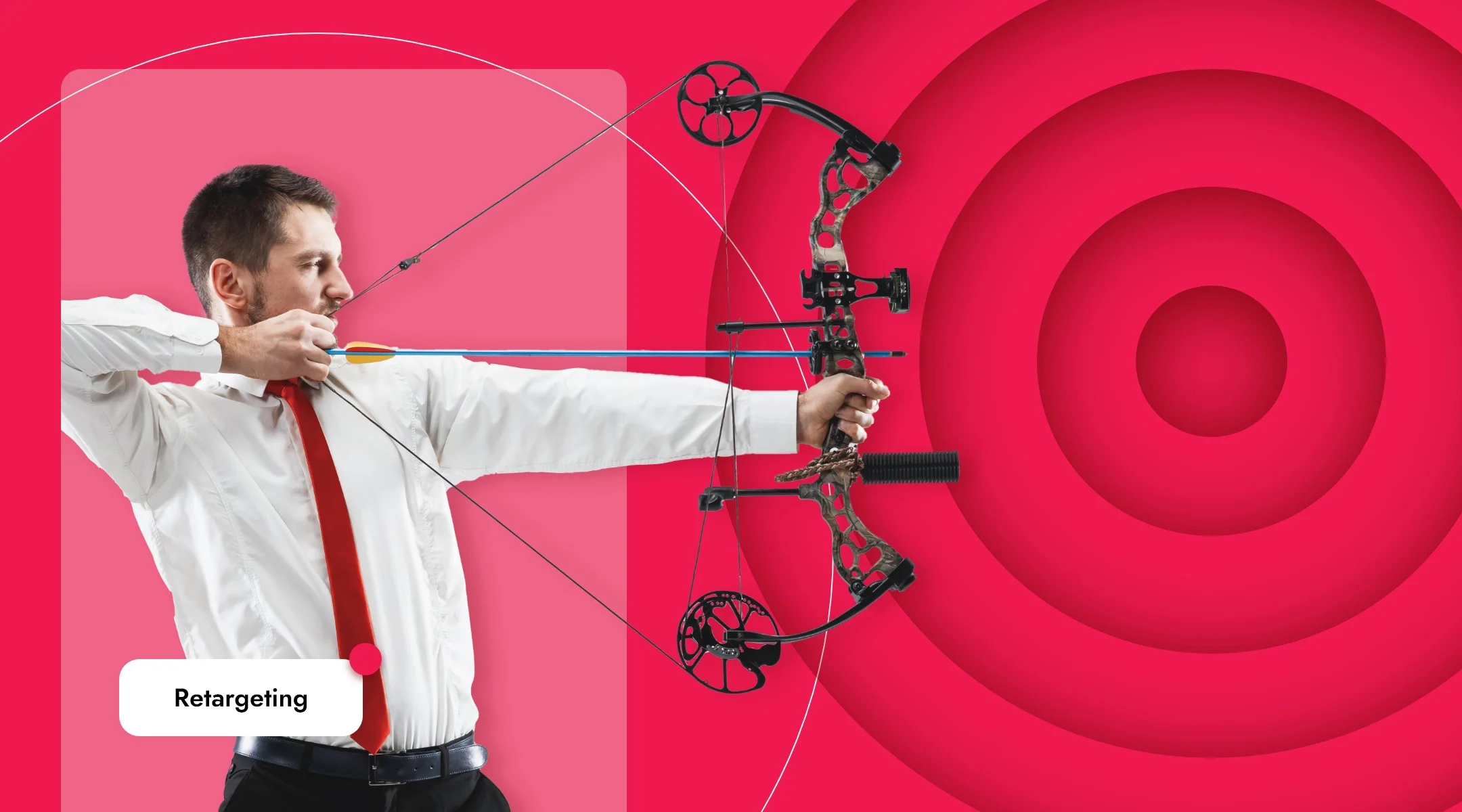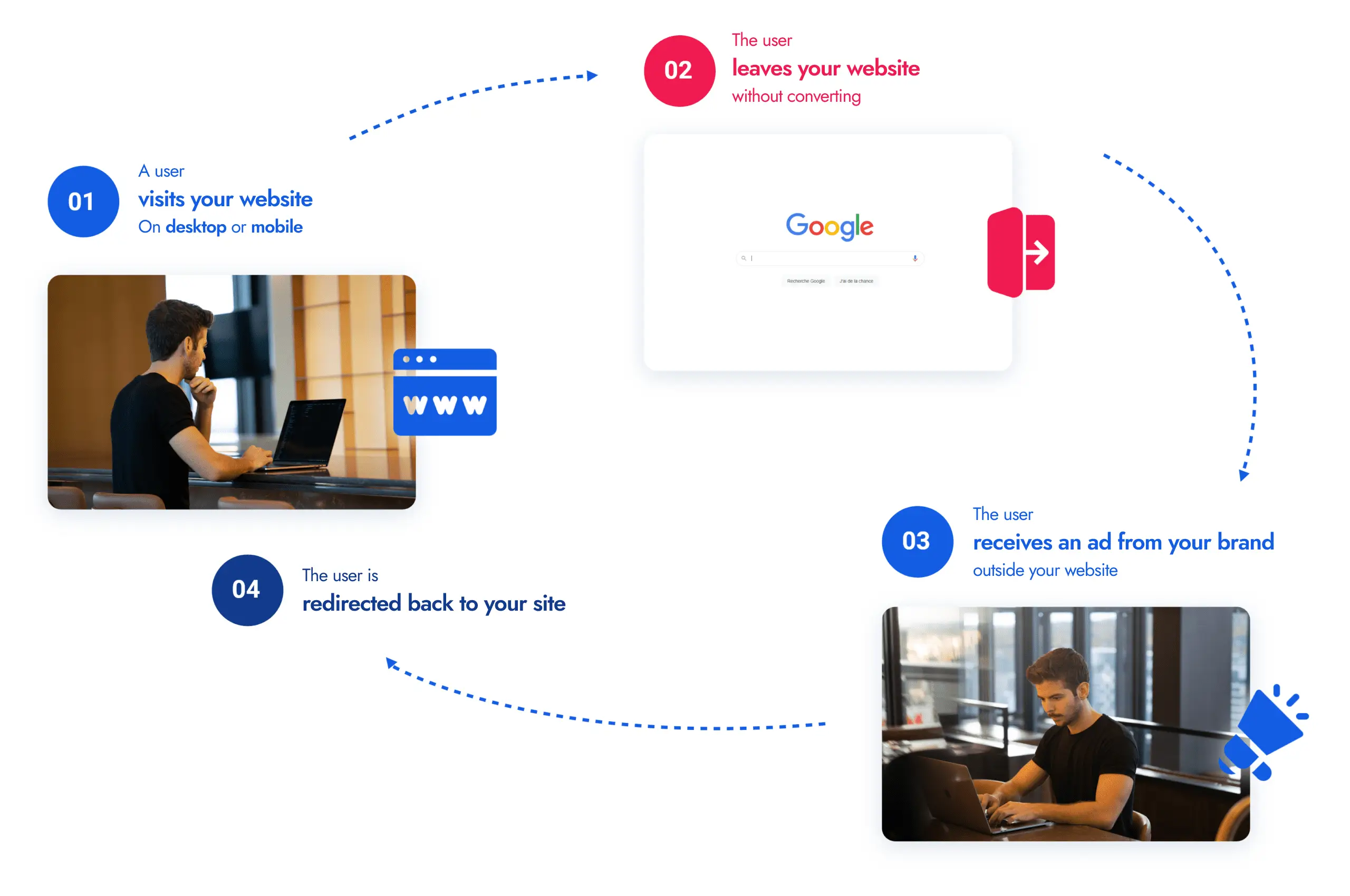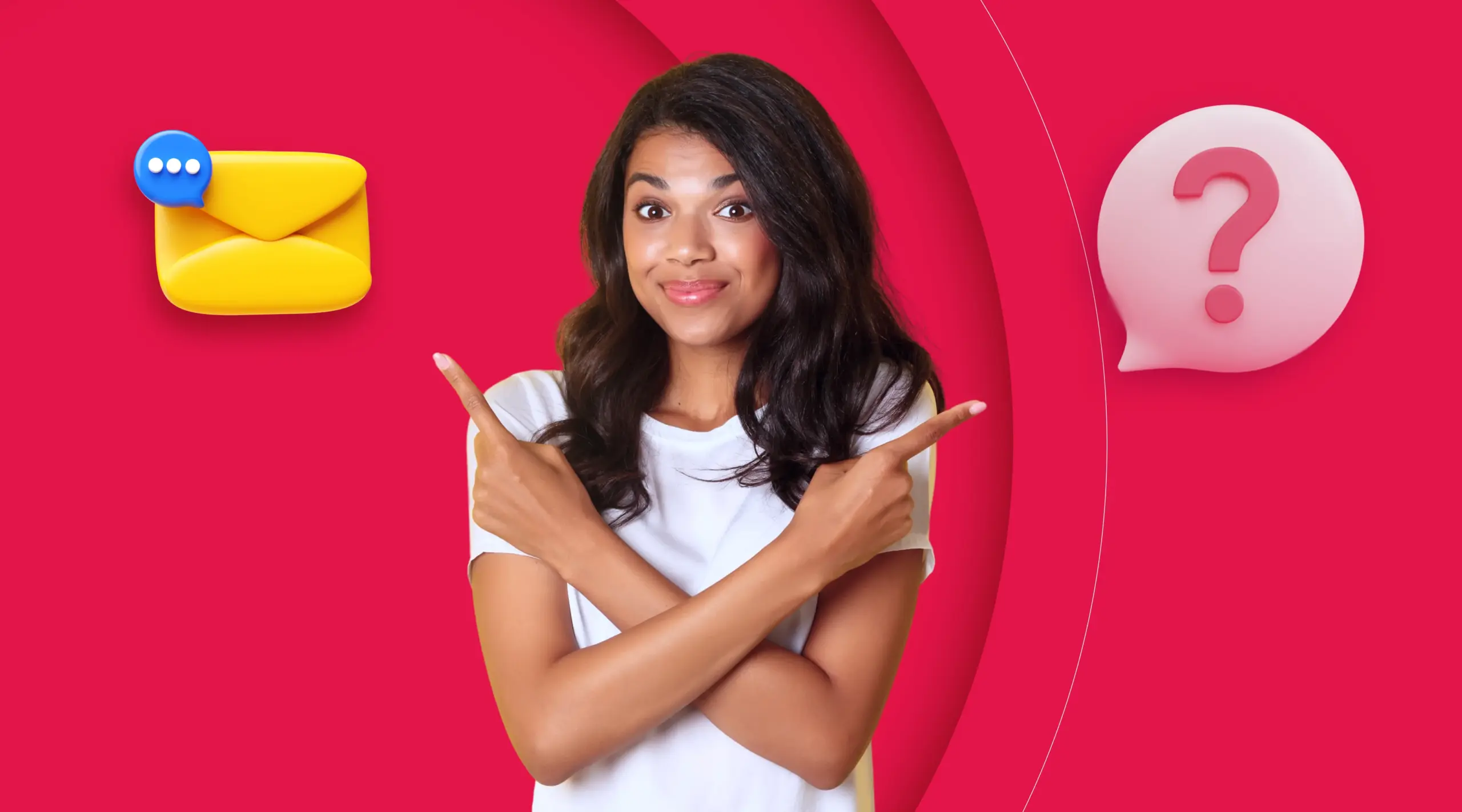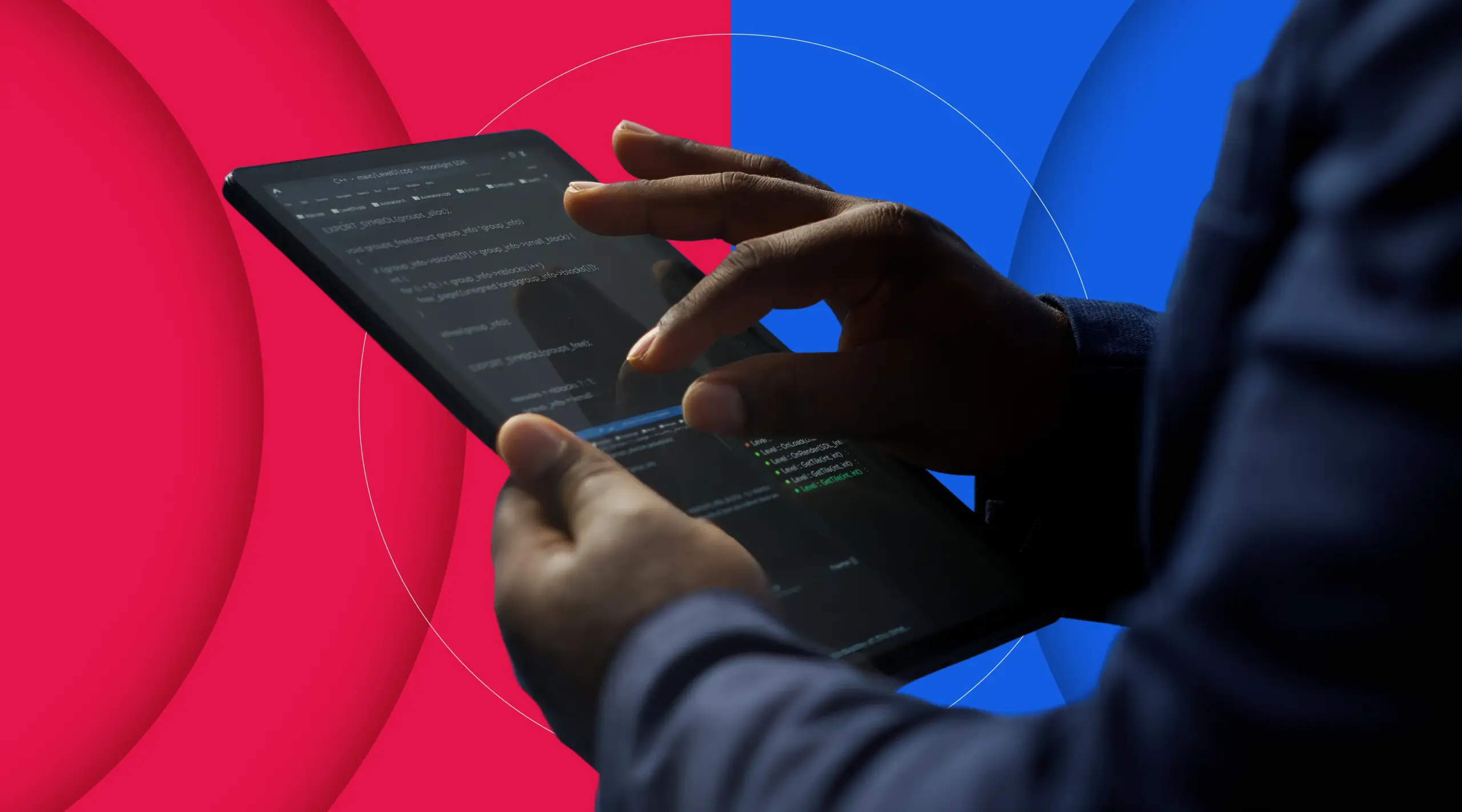
🕒 Updated on
You spend thousands of euros to bring visitors to your site. But you know that around 98% of these visitors will leave your site without making a purchase. How do you get them to come back and, above all, convert them? That’s where retargeting comes in.
Benefits, tools to use, best practices… An overview of this proven marketing technique for re-engaging your website visitors and maximizing your conversion rate.
- What is retargeting?
- How to set up an effective retargeting campaign?
- What are the most effective tools for retargeting?
- What's the budget for a retargeting campaign?
- Measuring the effectiveness of a retargeting campaign
- Retargeting success stories
- Lessons learned 👌
- FAQ: your most frequently asked questions
What is retargeting?
Retargeting enables you to reach Internet users who have visited your website, by serving them targeted ads (visual or textual) when they browse third-party sites or apps. All based on behavioral data from their browsing history.
Example: I browse an online clothing site, spot a sweater but don’t buy anything. I then go to a women’s magazine website, where I’m exposed to a display ad for the sweater I’d previously looked at.
Why use retargeting?
Retargeting has several objectives, and is aimed at prospects who have already shown an interest in your brand.
1. Increase brand awareness
Launching a retargeting campaign can increase brand awareness. As the targeted Internet users have already shown an interest in your products or services, you increase your chances of converting them into customers by exposing them again.
Retargeting ads remind prospects of your company, reminding them of your value or the appeal of your products or services.
2. An effective way to turn interest into conversion
As I said in the introduction, only 2% of visitors convert on their first visit. Retargeting helps to re-engage the other 98%.
This technique boosts returns to your website, as it allows you to target the right consumers, at the right time, with the right product. So, pushing your campaigns to interested prospects increases ROI vs. traditional campaigns. Obviously, personalization is key in this kind of campaign to increase your impact.
For example, it’s possible to retarget visitors who have spent a certain amount of time on a specific product page. An interested visitor will tend to spend more time on the web page, as he’ll read it carefully instead of skimming over it.
3. Nurture and qualify your prospects
Retargeting people who consume your content by offering them new resources can increase their interest in your product or service. With retargeting, for example, you can retarget readers of your blog or news pages to offer them the chance to download a white paper or restricted-access resource.
This lead nurturing strategy enables you to position yourself as a reference in your field, thanks to relevant and interesting content. Every return visit offers a new opportunity to sell and generate revenue.
4. Reduce cart abandonment
The items are there, in the customer’s shopping cart. Retargeting enables you to retarget these users to encourage them to complete their order.
Advertising to these users increases the chances of turning them into active customers.

5. Encourage repeat purchases
Retargeting former customers who have already made a purchase on your site and encouraging them to buy again is an excellent way of generating new sales and increasing their lifetime value.
Retargeting can also be used to implement a cross-selling strategy, offering accessories or additional products to customers who have already placed orders.
How does retargeting work?

Retargeting is a cookie-based technology that uses a simple Javascript code to “anonymously track” a web surfer. 🕵️
- Website visit: when an Internet user visits your site, the Javascript code placed on your website enables this visitor to be tracked thanks to cookies that retrieve and store data ;
- Browsing other websites: the visitor browses another website, where advertisements are displayed;
- Display of targeted ads: cookies in the visitor’s browser are analyzed. Where appropriate, advertisements corresponding to the visitor are displayed;
- Return to the original site: after clicking on the ad, the surfer returns to the brand’s site a second (third, fourth…) time.
The whole process is automated as soon as the page loads: the ad space is purchased and thead appears next to the page content.
How to set up an effective retargeting campaign?
Choosing the right lever
There are several types of retargeting:
- Retargeting by cookies: display of ads based on visitor behavior (Google Ads, Facebook Ads, etc.).
- Retargeting by e-mail: visitor follow-up via personalized e-mail campaigns.
- Retargeting via Web Push Notifications: effective, RGPD-compliant solution for re-engaging your audience without relying on third-party cookies.
Segmenting your audience
Segmentation enables you to offer a message tailored to each user profile. Here are some relevant segmentation criteria:
- Visitors who have abandoned their shopping cart.
- Customers who have visited product pages without purchasing.
- Users who have been inactive for some time.
Create engaging ads
- Use attractive visuals consistent with your brand.
- Include a clear call to action (e.g. “Complete your purchase now!”).
- Test different advertising creatives to maximize your performance.
Optimize ad delivery
- Limit frequency: too many displays can tire the user.
- Exclude customers who have already converted (sounds obvious, but forgetfulness happens faster than you think!).
- Adapt the timing: some campaigns work better if they are sent very quickly after the initial visit.
What are the most effective tools for retargeting?
The retargeting strategy can be implemented on a number of different retargeting channels. To make your choice, you need to take several factors into account:
- Your budget: some channels can be more expensive than others, so it’s important to plan accordingly. But with one or even a few hundred euros a month, you can already launch your first campaigns.
- Your objectives: these can be many and varied. Traffic, brand awareness, conversion, etc.
- The customer journey: if many visitors abandon their shopping carts, retargeting by e-mail or web push could be a relevant option to get them back.
Here are a few essential platforms for your retargeting campaigns:
- Google Ads (Display & Search Retargeting). Google Adwords search retargeting allows you to display targeted search results on keywords relevant to your brand. The Google display network allows you to display a campaign in the form of banner ads, on sites relevant to your company’s sector of activity.
- Meta Ads (more suitable for B2C) and LinkedIn Ads (ideal for B2B): these social networks, with their wealth of data on Internet users, also enable fine-tuned targeting. Retargeting can take the form of posts or videos, depending on the network chosen.
- Email can also be used for retargeting, subject to the user’s consent.
- Adrenalead Web Push Notifications (innovative alternative to third-party cookies)
- Criteo & AdRoll (platforms specialized in dynamic retargeting)
These different levers help keep your brand in the spotlight and bring qualified traffic back to your site. Conversion rates are much higher than with traditional socio-demographic targeting. It’s an effective way of re-engaging an audience that has already interacted with your brand.
Retargeting in display banners
Retargeting in display advertising refers to the banners displayed on many sites and blogs that have decided to monetize their space. This is the most widespread channel.
For this type of retargeting, you need to use advertising networks such as Adroll or Google Ads, which manage the site’s ads and the advertisers’ bids. The adverts most relevant to the user (based on the user’s cookies) will be displayed.
Retargeting on social networks
The main social networks, such as Facebook, LinkedIn, X, Snapchat, Youtube and TikTok, allow you to display sponsored publications on their platform and through a network of partners.
You can launch a Facebook retargeting campaign directly, taking advantage of the social network that offers the most retargeting possibilities and is the most widely used today.
The key is to choose the network most used by your target audience, to guarantee the best possible conversion rate.
Email retargeting
Email retargeting only works if visitors to your website have consented to give you their email address, in order to comply with the General Data Protection Regulation (RGPD).
Internet users who have given their prior consent receive a message directly in their mailbox, to encourage them to return to your website.
Emailing can also be used to push premium content offers (as part of a content marketing strategy) or promotional offers, depending on the type of product or service on offer.
Retargeting via Web Push Notification
The snag in a display retargeting strategy? Adblocks. More and more web users are installing one, to avoid being polluted by display ads.
The snag in an e-mail retargeting strategy? Having the data.
Web Push Notification is adblocker-free, since it is displayed directly on the user’s terminal. And as it doesn’t require personal data, but does ask for the user’s consent, it becomes a powerful communication channel. This concise format includes a title, a 145-character description, a logo, and a CTA (call to action) with a redirection link.
How can Web Push be integrated into your retargeting campaigns?
- Instant re-engagement
Web Push Notification allows you to instantly re-engage visitors who have left your site, bringing them back with special offers or personalized reminders. - Promotions and offers
Announce special promotions via Web Push Notification to encourage visitors to return and make a purchase. - New products
Inform visitors of new product launches or important updates with targeted notifications.
The site’s Web Push Notifications subscribers can be contacted directly by the brand, without necessarily being browsing the web. Unlike other retargeting levers, Web Push enables retargeting of Internet users directly on their computer or mobile screen. It’s a real innovation for digital marketing, enabling brands to capture their audience on-site and retarget them “on-device”.
This format is a sure-fire lever for brands, since it dispenses with the need for any broadcast medium. Not to mention that the solution also cuts through the ad-blocking net. This is no mean feat when you consider that almost 47% of Internet users use ad blockers!
What’s the budget for a retargeting campaign?
The budget varies according to several factors:
- Your chosen platform (Google Ads, Facebook, etc.).
- Competition in your sector.
- The quality of your target audience.
Best practices :
- Start with a small budget and adjust according to performance.
- Test different bidding strategies (CPC, CPM, CPA).
- Limit yourself to one channel if you have a limited budget.
- Remember to change your ads from time to time, to prevent web users from getting bored of your campaign.
- Keep your acquisition costs in line with your target CPA.
- Segment your creative according to your target audience, so that it matches their needs as closely as possible.
Measuring the effectiveness of a retargeting campaign
To optimize your campaigns, follow these KPIs:
- Conversion rate: number of visitors who complete the desired action.
- Cost per conversion: measure of return on investment.
- Click-through rate (CTR): indicator of ad engagement.
- Display frequency: to avoid over-delivery.
Retargeting success stories
- E-commerce: an online store increased its conversion rate by 30% by targeting visitors who had abandoned their shopping carts.
- SaaS: a B2B company reduced its customer acquisition costs by 25% thanks to fine-tuned segmentation and personalized messages.
Lessons learned 👌
- Retargeting is an essential strategy for maximizing online conversions and customer loyalty.
- It enables you to reach Internet users who have already shown an interest in your brand with targeted advertising.
- Retargeting can be carried out through a variety of channels, including social networks, e-mail, search engines, mobile applications and Web Push Notifications.
- Choosing the right channel depends on your budget, your marketing objectives and your customers’ browsing habits.
- The benefits of retargeting include increasing brand awareness, turning interest into conversion, qualifying prospects, reducing cart abandonment and encouraging re-purchase.
- Web Push Notification is emerging as an effective cookieless solution in the face of the end of third-party cookies. Other advantages include easy unsubscription by the web user, the ability to bypass ad blockers and the possibility of maintaining a link with subscribers.
- Understanding the difference between proprietary and third-party cookies is essential in the context of retargeting.
In conclusion, retargeting remains essential to digital marketing, boosting your conversion rates and audience loyalty. Solutions like Web Push Notification offer powerful assets, in an ever-changing advertising landscape. Don’t underestimate the potential of retargeting to boost your online presence and build customer loyalty.
FAQ: your most frequently asked questions
What’s the difference between retargeting and remarketing?
Is retargeting compliant with GDPR?
How can you improve retargeting performance?
What is a cookie?
It allows a user to be recognized when returning to a website.
Cookies have become a pillar of digital advertising because they were developed to offer a better, more personalized user experience and allow websites to remember a user’s visit.
Cookies contain personal data. Since the GDPR was implemented and under CNIL recommendations, websites have cookie obligations to protect users’ personal information.
A visible banner must inform you of the cookie purpose; you can then either give consent or configure cookie preferences.
What’s the difference between first-party and third-party cookies?
First-party cookie:
Third-party cookie:
Missed our webinars?



